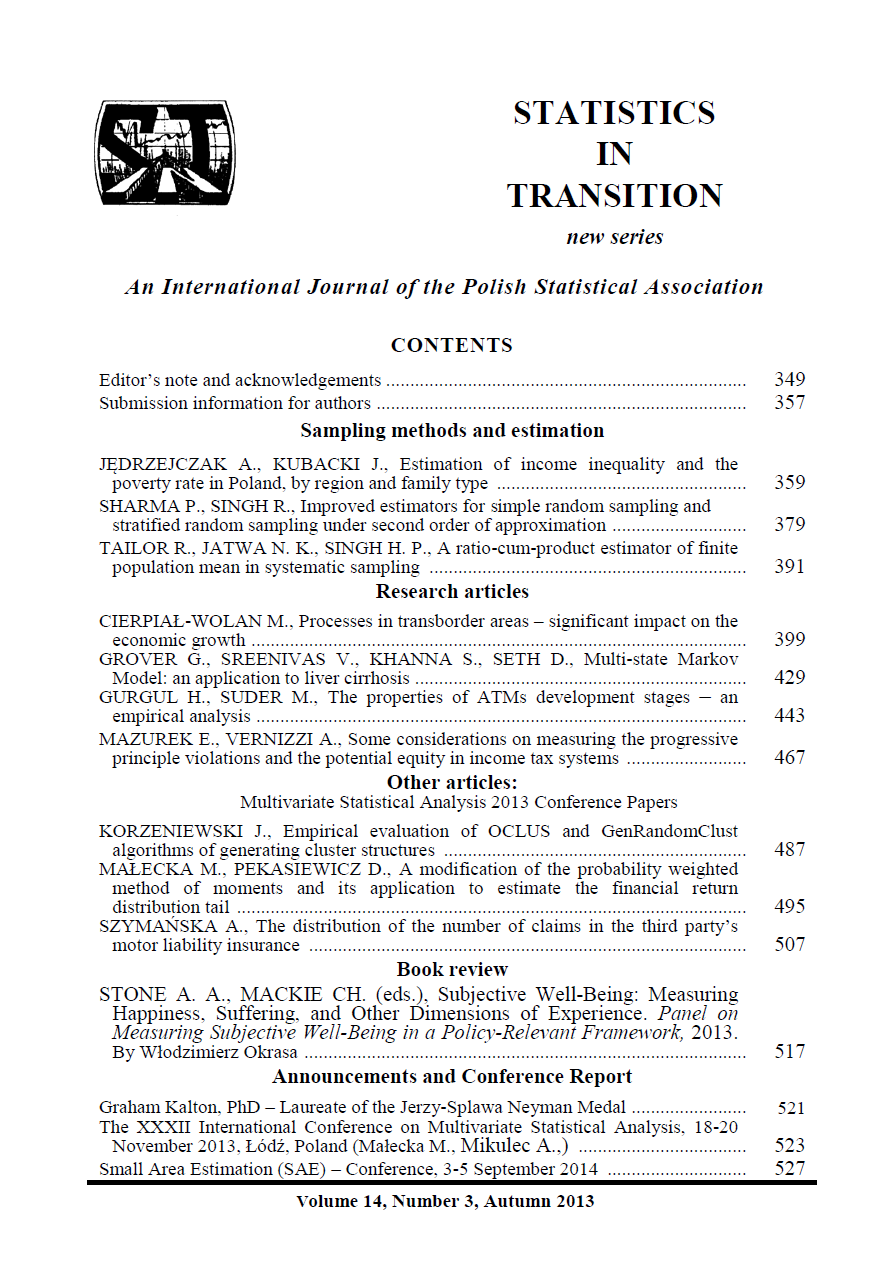ARTICLE
ABSTRACT
High income inequality can be a source of serious socio-economic problems, such as increasing poverty, social stratification and polarization. Periods of pronounced economic growth or recession may impact different groups of earners differently. Growth may not be shared equally and economic crises may further widen gaps between the wealthiest and poorest sectors. Poverty affects all ages but children are disproportionately affected by it. The reliable inequality and poverty analysis of both total population of households and subpopulations by various family types can be a helpful piece of information for economists and social policy makers. The main objective of the paper was to present some income inequality and poverty estimates with the application to the Polish data coming from the Household Budget Survey. Besides direct estimation methods, the model based approach was taken into regard. Standard errors of estimates were also considered in the paper.
KEYWORDS
income inequality, poverty, variance estimation, small area statistics
REFERENCES
ALY, E., HERVAS, M., (1999). Nonparametric Inference for Zenga's Measure of Income Inequality, Metron, LVII (1-2), pp. 69–84.
BRUCH, CH., MÜNNICH, R., ZINS, S., (2011). Variance Estimation for Complex Surveys, AMELI project, Deliverable 3.1.
FABRIZI, E., FERRANTE, M. R., PACEI, S., TRIVISANO, C., (2011). Hierarchical Bayes Multivariate Estimation of Poverty Rates Based on Increasing Thresholds for Small Domains, Computational Statistics & Data Analysis, 55 (4), pp. 1736–1747.
FAY, R. E., HERRIOT, R. A., (1979). Estimation of Income from Small Places:An Application of James-Stein Procedures to Census Data, Journal of the American Statistical Association, 74, pp. 269–277.
JĘDRZEJCZAK, A., (2011). Metody analizy rozkładów dochodów i ich koncentracji, Łódź University Press, Łódź.
JĘDRZEJCZAK, A., KUBACKI, J., (2010). Estimation of Gini Coefficient for Regions from Polish Household Budget Survey using Small Area Estimation Methods, [in:] Survey Sampling Methods in: Economic and Social Research, Edited by Wywiał J., Gamrot W., Akademia Ekonomiczna w Katowicach, Katowice, pp. 109–124.
MOLINA, I, RAO, J. N. K., (2010). Small Area Estimation of Poverty Indicators, Canadian Journal of Statistics 38, pp. 369–385.
LANGEL, A., TILLÉ, Y., (2013). Variance Estimation of the Gini Index: Revisiting a Result Several Times Published, Journal of the Royal Statistical Society: Series A, 176 (2), pp. 521–540.
PANEK, T., (2008). Ubóstwo i nierówności: dylematy pomiaru, in: Statystyka społeczna – dokonania, szanse, perspektywy, BWS, t. 57, GUS, Warszawa, 2008, pp. 96–108.
RAO, J. N. K., (2003). Small Area Estimation, Wiley, London.
SÄRNDAL, C. E., SWENSSON, B., WRETMAN, J., (1997). Model Assisted Survey Sampling, Springer, New York.
SEN, A., (1976). Poverty - an Ordinal Approach to Measurement, Econometrica 44, pp. 219–231.
SHAO, J., CHEN, Y., CHEN, Y., (1998). Balanced Repeated Replication for Stratified Multistage Survey Data under Imputation. Journal of the American Statistical Association, 93 (442), pp. 819–831.
WOLTER, K., (2003). Introduction to Variance Estimation, Springer-Verlag, New York.
ZEHNA, P. W., (1966). Invariance of Maximum Likelihood Estimation, Annals of Mathematical Statistics 37, pp. 744–745.
ZENGA, M., (1984). Proposta per un Indice di Concentrazione Basato sui Rapporti tra Quantili di Popolazione e Quantili di Reddito. Giornale degli Economisti e Annali di Economia, 48, pp. 301–326.
ZENGA, M., (1990). Concentration Curves and Concentration Indices Derived from Them, in: Income and Wealth Distribution, Inequality and Poverty, Springer-Verlag, Berlin, 94–110
